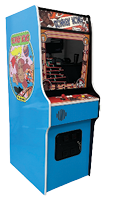Exploring the retro video game renaissance
Pop Culture: Retro Video Games
By Robert Matsumura, Contributing Writer

In recent years nostalgia has settled into the gaming industry. Despite the continuing demand for the newest, most realistic, imaginative video games for both consoles and streaming platforms, many enthusiasts are increasingly looking to the past for a familiar, relaxing and affordable gaming experience.

With the dizzying array of tantalizingly new games out there, complete with ultra-high definition graphics and immersive music and storylines, the rising popularity of old low-tech games with pixelated graphics and simplistic controls is a bit of a head-scratcher. In order to wrap one’s mind around this curious phenomenon, it’s important to understand what the term “retro game” refers to. In gaming parlance the term “retro gaming” instantaneously evokes primitive but charming 8-bit graphics, intuitive straightforward gameplay that is addictive and challenging, yet is, at its core, innately simple.

The heyday of these retro games was back in the 70s and 80s when the internet was still a dream, and words like “cell phone” and “streaming” had not yet entered the common lexicon. During this era, arcade games like Donkey Kong, Centipede, Asteroids, Pac-Man, and Space Invaders reigned supreme. While many of these games eventually made it onto various at-home consoles, the original experience was to play these games standing up on arcade machines located in pizza parlors, convenience stores and malls across America.
For those of us who grew up during this era the nostalgia factor is immense. As the world continually grows faster and more complex, there is a certain comfort in the return to something familiar. Engaging again with the graphics, sounds and challenges of these simple games has the ability to evoke the past, like a time capsule transporting one back to the days of their youth. Whether rescuing the princess in the various castles of Super Mario Brothers, zapping fast flowing insects in Centipede or defending humanity from invaders from outer space in Galaxian or Space Invaders, engaging once again with these simple yet thrilling games is like reacquainting oneself with an old friend.
Another lure of retro games is their simplicity. Unlike contemporary video games whose complexity often mirrors real life, retro games offer a binary experience that requires minimal decision making and strategizing. In a world where ever-evolving technology demands increasing levels of expertise and knowledge, the straightforward gameplay of retro games can be a refreshing change of pace. Basic hand/eye coordination and reaction time are typically the skills required in retro games, versus the detailed storylines and game mechanics common to today’s popular titles.

Aside from nostalgia and relaxing game play, the affordability of retro gaming is also appealing. The expense of today’s popular titles creates a strain on the pocketbook for budget-minded individuals. The inexpensive price of retro games — frequently bundled together at minimal cost — creates a democratizing effect, wherein the vast majority of gamers can afford to participate, rather than only the hardcore few willing to shell out significant dollars to stay up to date on the latest and greatest new releases.
Finally, one cannot discount the aesthetic appeal of retro games with their pixelated graphics and jaunty chiptune soundtracks that impart a certain charm to these old titles. While highly orchestrated musical scores and jaw-dropping HD visuals are indeed impressive from a technical standpoint, there are times when simple equates to good. In a sense, retro games are the comfort food of the video game industry. While gourmet cuisine can be an amazing culinary experience, there are times when you simply desire a good old burger and fries. Leaning over a classic arcade machine, joystick in hand, is a completely different experience to gaming online via the latest PlayStation or Xbox console wearing a headset and communicating in real-time with players around the globe.

So how has the recent resurgence in retro game popularity affected the gaming industry? The surging demand for retro games has manifested itself in a myriad of ways, from the creation of small hand-held arcade machines for gamers on the go to the digital remastering of classic retro titles. Game designers are also incorporating visuals, sound effects, and game mechanics from the old retro titles and developing new games that capture the essence of these timeless originals. In cities across the globe the burgeoning demand for retro video games has spawned arcade establishments catering to gamers wishing to play the old classics standing up, on machines like those of their youth. Often these new arcade establishments also double as restaurants serving food and beverages to hungry gamers as they strive to save the world from galactic invaders or guide Pacman through a labyrinth of hungry ghosts.
As one might expect, the surging popularity of retro video games has spurred demand for old gaming consoles. The resale market on sites such as eBay for vintage Atari, Nintendo, and Sega Genesis consoles has exploded as the younger generation of gamers discovers these old classics, and Boomers reengage nostalgically with the favorite games of their youth. The demand for retro game paraphernalia has also moved in lockstep with the demand for the old consoles and games cartridges, driving a craze for all things retro gaming.
No matter what your age or level of gaming experience — Baby Boomer to Gen Z, avid gamer to newbie – retro video games have something to offer everyone. Whether you grew up in the 70s or 80s and seek a nostalgic blast to the past, or hail from a more recent generation, the realm of retro gaming is a wonderful respite from the complexities of our modern life—digital comfort food for the soul!
